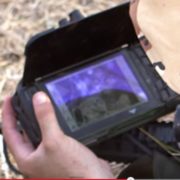Do you need a computer that is night vision compatible? Before you buy, you should know the answers to these 10 questions.
What is a night vision compatible computer?
Night vision compatible computers do NOT possess the capabilities of night vision goggles. They do NOT allow you to see in the dark. Instead they restrict their emission of light, in order to prevent interference with or detection by night vision goggles.
Who needs a night vision compatible computer?
Generally, there are two classes of people who need night vision compatible computers: aviation crews and military ground troops, especially Special Forces. Ground forces use computers with decreased light emissions to avoid detection by the enemy. Airplane crews need computers whose light emissions are restricted, so they don’t blind a nearby pilot who is using night vision goggles.
Are there differences between night vision compatible computers used by aviation crews and those used by Special Forces?
Yes. Filters used to suppress the transmission of light have different level of strength. AMREL’s off-the-shelf night vision solutions use filters that permit light transmission of 2.5%, which is a commonly requested level (alternative filter ranges are available by request). Special Forces requirements can go as low as 1%. Aviation standards (MIL-STD 3009) are not as strict and permit 20% transmission.
One reason there are differences between the two types of night vision compatible computers is that they are used differently. A pilot will use his night vision goggles to fly, but will switch to using his naked eye when viewing instrumentation within the cockpit. On the other hand, a soldier on the ground will use his night vision goggles to view nearby objects as well as ones in the distance.
Another difference is that aviators prefer their night vision to have an anti-glare surface. Ground troops on the other hand do not care.
Sometimes, the markets overlap; Special Forces in airplanes will use computers with night vision solutions to avoid blinding the pilot who is using goggles to fly.
What is “black background”?
Some Naval applications demand that that night vision compatible equipment emit zero radiation when they are turned off. The requirement for this specification is called “black background.” This leads to stricter requirements than is found in aviation applications.
Can night vision compatible computers have a workable touch screen?
Yes. The filter can diminished the effectiveness of the touch screen slightly, but most people do not notice this.
Why is the suppression of infrared range emissions important?
Night visions goggles use infrared (IR) range. Therefore, night vision filters must suppress light transmitting in that range, so that an enemy using night visions goggles cannot see their computer. Sometimes, you will see phrases about night vision compatible computers, such as “…. reduces your infrared signature.”
Consider the following graph used by Cevians, LLC (formerly a division of Wamco Inc.), an industry leading supplier of filters, to illustrate the suppressive properties of one of their products. Infrared starts at about 700 nm, so this graph shows zero transmission in that range.
What is “full color rendering” and do I need it?
Night vision filters can suppress the spectrum unevenly. Sometimes, the image on the display of a night vision compatible computer will look distorted, even monochromatic.
This is a problem for a variety of applications, especially mapping, which may use color to convey critical detail and information
Night vision filters can be constructed for “full color rendering.” Red looks red, yellow looks yellow and so on. For many applications, this is essential.
What the heck is U´ and V´?
Pronounced “U prime” and “V prime,” these coordinates describe color distortion caused by filters (even “full color” ones have some). An expert can look at u’ and v’ and know how whether or not the filters are appropriate for his application.
Why should I care if my filter is “polymeric”?
Filters made from polymeric materials are not flammable. Especially important for aviation applications.
Are night vision compatible computers “sunlight readable”?
Not with the filters on. Many night vision compatible computers have filters that are removable, so they can be used in the daytime. This leads to an important often unasked question, “Where the heck do I put my night vision filter when I am not using it?” This may seem to be a trivial detail, but when designing a night vision solution, it is an important consideration.
Click here to learn about AMREL’s night vision solutions.












